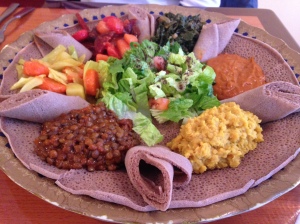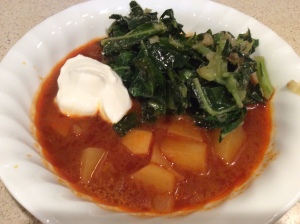When I think of Eritrea, I think of Asmara, a restaurant in Central Square, a neighborhood in Cambridge, Mass, that I lived in during two periods of my life, first in my later college years and again when Derek and I moved in together. The restaurant was there during both periods, and was where I had Eritrean/Ethiopian food for the first time as a college junior. Derek and I also had one of our final meals there before moving from Cambridge to Buffalo, a fitting end to my days as a Central Square resident. (Even if Derek and I return to the Boston area someday, it’s doubtful that we’ll be able to afford the Central Square rents, which always seem to be increasing.)
But, I digress. Even though I’ve long been familiar with Asmara the Central Square restaurant, I hadn’t learned a lot about its namesake, the Eritrean capital also called Asmara, or about Eritrean culture in all that time. I had assumed Eritrea has similar food to Ethiopia, because Asmara the restaurant’s menu is similar to the menus of Ethiopian restaurants I’ve also tried. We’ve already globetrotted to Ethiopia on a detour over two years ago, so here was our chance to zero in on Eritrea.

We started our Eritrean weekend with some ful, mashed fava beans accompanied with diced vegetables and pita bread, for breakfast. You may recall that we also had this dish for breakfast fairly recently when we globetrotted to Egypt (though the word was transliterated as fool). Eritrean food has both Arabic and Italian influences, and this dish highlights the Arabic side. This version of ful was spicier, with some berbere, a spice we also used in our Ethiopian cooking, and chopped jalapeño peppers instead of bell peppers. The yogurt and feta helped balance out the spicy flavors a little.

I started working on a sweet bread called hembesha from the Eritrean section of The World Cookbook. Since it was a yeast bread that required a lot of time for rising, it was pretty much lunch time by the time the dough was on its second and final rise. Luckily, I had a fast Eritrean recipe on hand, perfect for lunch, fata, a bread salad with a spicy tomato sauce. This salad shows the Italian influence on Eritrean cuisine, as the Italians also make a salad with bread and tomatoes, called panzanella. Again, the fata was quite spicy, even though I halved the amount of fresh chili pepper, so we were glad to eat this salad with dollops of thick yogurt.

After lunch, we turned to Barby and Geography Now for an overview of Eritrea:
What struck me about this Geography Now episode was Eritrea’s lack of close ties; all the other countries we’ve watched Barby cover so far have had close friendships with at least one or two other countries.
The next video we watched, a longer video Derek found on Vimeo called “Come and See”, helped explain this a little. We learned more history: Eritrea has only been an independent nation since 1993, and prior to that, had been occupied by Italy, followed by Great Britain, and then Ethiopia. After gaining independence, Eritrea refused help from international organizations like the World Bank, in favor of self-sufficiency. Those in power in Eritrea believe that as a result, they are a victim of bad press in the international media.
It’s hard for me to believe that the media is involved in a conspiracy to make Eritrea look bad. My skepticism is probably related to my opinions regarding the current political situation in the United States, and the American president’s labeling of any news that presents his administration in an unflattering way as “fake news.” There are things about Eritrea itself that also make me question if things are as great in Eritrea as “Come and See” makes them out to be. There is only one political party, and there have been no national elections since the country’s independence; the same man has been president since 1993.
We would look at media depictions of Eritrea later, but we took a break and had some of the hembesha that I had baked.

For dinner, we walked to an Ethiopian restaurant about 20 minutes from our apartment, called Fast N’ Tasty. While we would have liked to go to a restaurant that identified as Eritrean like our old Asmara, this was the next best thing. We shared a veggie combo platter, which had potatoes and cabbage, collard greens, yellow split peas, lentils, ground chickpeas, and red beets, with injera bread.

The cover photo, in case you were wondering, is of a wall hanging on one of the restaurant’s walls.
We resumed our Eritrean weekend on Sunday morning, with more ful, diced veggies (with half the amount of onion and jalapeño, since we struggled to finish those on Saturday) and pita. This time I also made some spiced tea, by boiling some cardamom pods, whole cloves, and a cinnamon stick with some water.
We spent most of the morning doing chores for the week ahead, snacking on some more hembesha for a mid-morning boost. For lunch, I made us more bread salad (again, reducing the amount of raw onion and jalapeño–we would be very wimpy Eritreans).
After lunch, we watched a BBC video from 2015, in which a BBC news team was allowed to visit Eritrea for the first time in 10 years. The team is chaperoned at all times, and only taken to sites approved by the government, mostly hospitals and health clinics that showcase the improvements made in maternal and newborn health. The government denies having secret detention centers where they imprison political dissidents (though some people who have escaped from Eritrea claim that they were held prisoner in such places), and stands by its policy of requiring every Eritrean adult to perform national service, though it acknowledges that people can end up serving a longer time than the stated 18 months.
For those with shorter attention spans, Derek and I found this short video explaining the history behind the tensions between Eritrea and Ethiopia to be succinct yet informative.
Later in the afternoon, Derek made his own blend of berbere spice (I had been using a mix I had made when we globetrotted to Djibouti last November). The spice blend went into the d’nish zigni, fiery potato stew, that he was making for dinner. He also prepared hamli, a dish of sautéed greens. Although neither recipe called for it, Derek also added some yogurt to both our bowls, since he was afraid the stew would be too spicy. While the stew was spicy, it wasn’t unbearably so.

While we weren’t able to globetrot to Eritrea while we still lived in Cambridge and when we could still go to Asmara the restaurant, I think we did a fairly good job representing Eritrean culture in Buffalo. Since we already globetrotted to Ethiopia, we’ll wrap up all the “E” countries with our next country, Estonia. Until then, selamat!
– Jess